Honey mushrooms are considered one of the most popular and productive fruit bodies among lovers of "quiet hunting". They got their name because they usually grow around stumps. These mushrooms grow in large colonies, so they are harvested with great pleasure. Having found just one stump with mushrooms, you can collect several baskets of these mushrooms.
If mushrooms can be mainly found on stumps, then the question arises: do mushrooms grow on trees? Translated from Latin, the word "honey mushroom" means "bracelet". This name is not surprising, because in addition to stumps, these fruit bodies grow on diseased and dying trees, growing in the form of a circle. It is not difficult to find such mushrooms in the forest, especially if there are often a lot of them in one area.
Edible mushrooms honey agarics that grow on living trees (with photo)
Honey mushrooms have thin, flexible and long legs, reaching 10, and sometimes 15 cm in height. Its color ranges from light honey to brown, depending on the soil and trees on which the mushrooms grow.
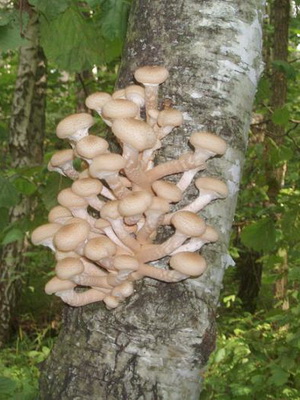
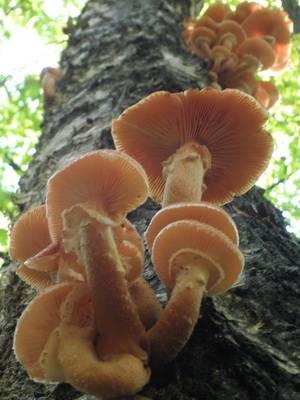
Pay attention to the photos of edible mushrooms growing on trees. Shown here that each piece has a film skirt. She frames the legs of honey agarics at a young age, and in an adult state the skirt is torn and hangs in "rags". The caps of real mushrooms are hemispherical in shape, covered with small scales. The color of the caps ranges from creamy yellow to red shades.
Honey mushrooms growing on a tree are known to all lovers of "quiet hunting", because they are able to capture large territories... It often happens that even on living trees, honey agarics feel great. In addition, they can be found near certain types of shrubs, such as hazel, in meadows, forest glades, in ravines and in damp alder groves.
For beginner mushroom pickers, we suggest looking at photos of mushrooms that grow on trees:
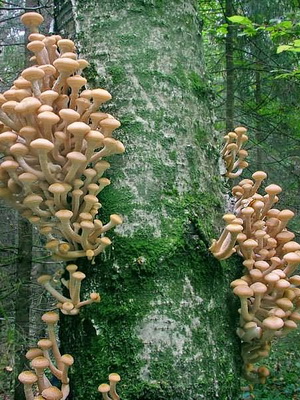
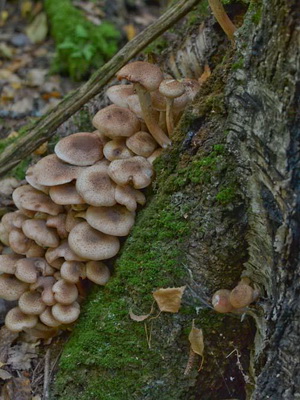
However, these fruiting bodies are often found in forest clearings, such as under power lines. Almost every tree stump is littered there. large groups honey agarics. On the stumps of what trees do honey agarics prefer to grow? These fruiting bodies are found throughout Russia, including the Northern Hemisphere and the subtropical zone. Honey mushrooms do not grow only in harsh areas eternal ice... Rotten stumps of birch, alder, aspen and oak are of great advantage. But other tree species are also "in demand" among honey agarics, for example, acacia and even fruit trees.
What trees do edible mushrooms grow on and what do they look like?
Edible mushrooms are divided into spring, summer, autumn and winter views... Let us note specifically on which trees edible mushrooms grow. Spring and summer honey agarics are common mainly on deciduous trees; trunks with damaged and rotten wood are especially preferred. And in mountainous terrain, summer mushrooms are found on spruce and spruce stumps. Honey mushrooms growing on coniferous trees have a bitter taste and dark color, although this does not affect their nutritional value in any way. Summer mushrooms have a leg up to 7 cm high and up to 1 cm in diameter. The lower part of the leg is covered with dark small scales. The "skirt" around the leg is narrow with some steep edges.
In deciduous forests temperate zone Russia can collect summer mushrooms from April to August. In a favorable climate, this species can bear fruit without interruption. Since summer mushrooms have false counterparts, experienced mushroom pickers advise to collect them only on the remains of deciduous trees, or better - exclusively on stumps left after cutting down birches.
The most popular among honey agarics is considered to be the autumn species, which is known as "real honey agaric", "osennik" or "Uspensky honey agaric". Experienced mushroom pickers are happy to share information about which trees fall mushrooms grow on. This species begins its growth in August and continues practically until November. Most often it prefers birch and birch stumps, then aspen, maple and oak. Usually, autumn mushrooms choose trees that show signs of decay or disease. Although sometimes these mushrooms can even choose a living tree. In particular, old birch forests with fallen trees or swampy birch forests with many rotten trunks and stumps are an expanse for them.
Do honey mushrooms grow on conifers?
On coniferous trees, autumn mushrooms are much less common, although their beneficial features and vitamins are not inferior to mushrooms growing on deciduous trees. These mushrooms can sometimes be selected from pines and spruces, as well as their stumps.
Autumn mushrooms are the largest representatives of their species, since their cap reaches 15-17 cm in diameter. There is a convex tubercle in the middle of the cap, and small scales are located on the surface of brown color. The skirt, framing the leg, comes off over time and forms a blanket hanging under the hat. Sometimes, during the dry summer months, autumn mushrooms are found even on drying deciduous trees at a height of about 2-3 m from the ground. Therefore, you need to have a large stick with a hook in order to collect these fruiting bodies.
At the beginning of June, edible meadow mushrooms appear, flashing yellow-brown among tall grass in fields, pastures, along forest paths and in ravines. As you noticed, meadow mushrooms honey mushrooms do not grow on a tree, preferring land.
The end of September and the beginning of October are notable for the fact that the season for collecting winter mushrooms begins. These fruiting bodies grow in families, which grow together with their legs on fallen poplars, maples, willows, aspens, as well as on their stumps. They collect winter mushrooms all autumn before the onset severe frosts... It is noteworthy that these mushrooms do not disappear in winter, but simply “fall asleep”. During thaws, practically until April, they continue to grow.
Winter mushrooms on trees look like a bright red or orange spot. V winter forest such mushrooms are very easy to see even from a distance. They do not have false counterparts due to their late fruiting. Although winter honeydew is considered a conditionally edible mushroom, many mushroom pickers call it the most delicious. In addition, winter mushrooms are the best for growing at home.
Do false mushrooms grow on trees and photos of mushrooms
However, autumn and summer mushrooms have false counterparts. Many are interested in the question: do false mushrooms grow on trees? The danger of these mushrooms is that they can grow next to edible species, one might say, right on one stump or tree. Therefore, if you find a family of honey agarics, carefully look for any false ones nearby. The main difference is the "skirt" on the leg, which is peculiar only to edible mushrooms. Poisonous mushrooms have a wormwood taste and a disgusting smell, reminiscent of a corpse.
Gathering mushrooms is a very reckless occupation, since there is a risk with edible mushrooms to bring home in a basket and false ones. Therefore, before you go on a "quiet hunt", brush up on all the necessary differences in your memory in order to be able to recognize the poisonous counterparts. We offer you to see photos of false mushrooms growing on a tree, which at first glance are very similar to the real ones:
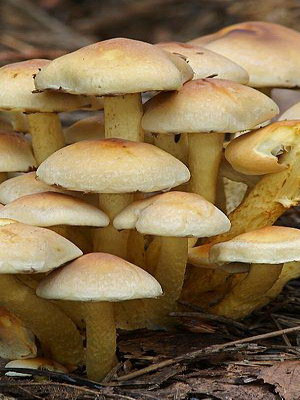
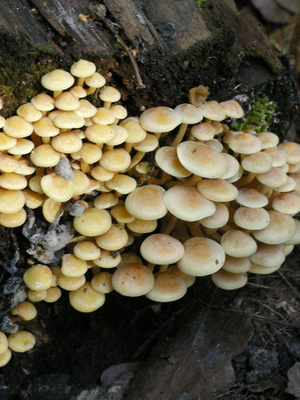
Another point that novice mushroom pickers need to remember - do not gather mushrooms close industrial enterprises or right next to highways. In this case, even edible mushrooms can lead to poisoning and harm to health.
Honey mushrooms are considered one of the varieties edible mushrooms with plates. They are divided into autumn, summer and winter. It's hard to say for sure what time to collect hemp mushrooms... Autumn mushrooms complete the mushroom season and are considered the most harvested and widespread mushrooms. They begin to collect them from the end of August and bear fruit for two to three weeks. If the summer turned out to be dry, then this period may be unnoticed or go to a later time. And on the territory of the Northern Hemisphere, the second stage of fruiting often occurs, depending on weather conditions... There, these mushrooms can grow until mid-October.
Summer mushroom begin to collect in early June and end in October. Unlike the autumn one, it has a much smaller hat, it is yellowish-brown in color, lighter closer to the center. This mushroom belongs to the fourth category, which is most suitable for drying, soups and pickling.
Winter honey agaric grows only on trees, in small clusters. It appears in the fall and remains under the snow in the winter. And in a fairly mild climate, you can collect mushrooms until March. It does not have a strong taste, it is mainly used in stews and first courses, as well as in pickled form.
How to distinguish a false honey from a real one
Inedible mushrooms are a number of mushroom names, outwardly similar to edible mushrooms. They like to grow in the same parts of the forest as the real ones, on a tree that is littered with stumps and stem parts in small groups. Therefore, it is easy to confuse them with false mushrooms. They are divided into three groups:
- inedible
- conditionally edible
- poisonous.
Therefore, you should not risk taking a mushroom if you are not completely sure of its edibility. If there is even a small part of the doubt that it is not false and can be used in cooking, it is best not to put it in the basket.
The first main point, according to it, it is easy to distinguish the mushroom from the inedible one - this is the presence of a ring with a film, a kind of skirt, on a leg. Such a ring is residual effect from the bedspread, playing the role of protection for the mushroom at a young age. Inedible mushrooms do not possess such a ring.
In addition, there are a number of others. distinctive features:
http://www.fermerbezhlopot.ru/wp-content/uploads/2015/08/mushrooms-hoppers.jpg 447w "width =" 514 "/>
- False honey mushrooms are tasty in smell, have mushroom flavor, while inedible mushrooms it is unpleasant and earthy.
- In inedible mushrooms, the caps are the most brightly and loudly colored, in contrast to the opposite ones. Shades can be sulfur yellow or pale red, it all depends on the species. For non-false mushrooms, the usual light brownish color is characteristic.
- In edible honey agarics, the top has small scales, while in the opposite ones there is nothing on it, it is smooth to the touch. But this does not apply to the old false mushrooms, since they also have a smooth hat.
- If we compare the seamy part of mushroom caps, they also have differences in color. Plates in inedible mushrooms yellow color, and in the old ones it is green or olive black. And in real mushrooms, they are creamy or yellowish-white.
- By taste false mushrooms have a bitter taste, but you should not try mushrooms, all of the above signs are quite enough to determine the edibility of the mushroom.
How and where to pick mushrooms, milk mushrooms, boletus, honey agarics
For an experienced mushroom picker, the listed qualities will immediately be remembered, and in the future they will help to distinguish, but for a beginner it is better to apply knowledge carefully and carefully. Since they are theoretical, and each person considers color and smell in their own way. Choose correct mushroom only experience will help. And for the first hikes, one should start from the indicative moment during appearance- this is the presence of a skirt on the legs of honey agarics. Now it becomes clear when to collect hemp mushrooms and how to distinguish mushrooms by sight.
There are several types of honey agarics. Some of them are deadly. These are noticeable false and sulfur-yellow mushrooms. They can be easily distinguished from edible varieties by their unpleasant special smell and appearance. Regardless of the species, all mushrooms grow in families.
Harvest season
The richest is traditionally considered autumn time, but there are often cases when it is possible to collect great amount honey agarics. Summer varieties are among the first to appear. Usually it is with them that the mushroom season begins.
In winter, you can also pick these miniature mushrooms. But the collection will not be as big as, say, the autumn one. But, nevertheless, experienced mushroom pickers find several families at this time. Perfect timing for autumn hunting - November or early December.
Among professionals, honey mushrooms are considered "smart" mushrooms. Therefore, they never appear earlier than the due date. For example, the winter variety cannot be found until October. And the autumn species will never appear in the spring. Therefore, cases of poisoning with mushrooms similar to honey agarics are extremely rare. Experienced mushroom pickers, going for the harvest, should remember this simple rule so as not to run into false fruits.
Mushroom places
Most mushrooms have their own personal growing areas, which are characteristic exclusively of this family. As a rule, it is thanks to this feature that they get their name. Honey mushrooms are no exception.
As you might guess from the nickname, these small mushrooms love stumps, and for their habitat they choose only old specimens. Slightly less often, honey agarics can be found that grow directly on the ground, but this is just visual illusion... In fact, these "earthen" species, in fact, live on the stump, or rather on the roots remaining from it, which are deep underground. We can only observe superficial growth of honey agarics.
Experienced mushroom pickers, in order to collect a very successful harvest, recommend memorizing the location of the stumps where the mushrooms were collected earlier. Natural feature the growth of this fungus determines the subsequent harvest of honey agaric previous location growth. Therefore, having collected fruits from one stump last year, you can be guaranteed to find them in the current one. True, if no one has collected them earlier.
On average, a stump without human intervention can succumb to the process of natural destruction for almost a decade. And mushrooms will multiply on it until it is finally destroyed.
In many cases, even after the wood dies, honey mushrooms continue to grow on the remnants of the root system, as a result of which we can find a full-fledged mushroom family on the surface.
Honey mushrooms are considered to be one of the varieties of edible mushrooms with plates. They are divided into autumn, summer and winter. It's hard to say for sure what time to collect hemp mushrooms... Autumn mushrooms complete the mushroom season and are considered the most harvested and widespread mushrooms. They begin to collect them from the end of August and bear fruit for two to three weeks. If the summer turned out to be dry, then this period may be unnoticed or go to a later time. And on the territory of the Northern Hemisphere, the second stage of fruiting often occurs, depending on weather conditions. There, these mushrooms can grow until mid-October.
Summer honey agaric begins to collect in early June and ends in October. Unlike the autumn one, it has a much smaller hat, it is yellowish-brown in color, lighter closer to the center. This mushroom belongs to the fourth category, which is most suitable for drying, soups and pickling.
Winter honey agaric grows only on trees, in small clusters. It appears in the fall and remains under the snow in the winter. And in a fairly mild climate, you can collect mushrooms until March. It does not have a strong taste, it is mainly used in stews and first courses, as well as in pickled form.
How to distinguish a false honey from a real one
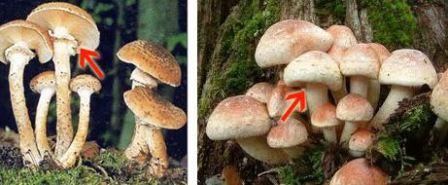
In edible mushrooms (left), the ring on the leg is clearly visible. False mushrooms (on the right) have no rings on their legs
Inedible mushrooms are a number of mushroom names, outwardly similar to edible mushrooms. They like to grow in the same parts of the forest as the real ones, on a tree that is littered with stumps and stem parts in small groups. Therefore, it is easy to confuse them with false mushrooms. They are divided into three groups:
- inedible
- conditionally edible
- poisonous.
Therefore, you should not risk taking a mushroom if you are not completely sure of its edibility. If there is even a small part of the doubt that it is not false and can be used in cooking, it is best not to put it in the basket.
The first main point, according to it, it is easy to distinguish the mushroom from the inedible one - this is the presence of a ring with a film, a kind of skirt, on a leg. Such a ring is a residual phenomenon from the bedspread, which plays the role of protection for the mushroom at a young age. Inedible mushrooms do not have such a ring.
In addition, there are a number of other distinctive features, false agarics:
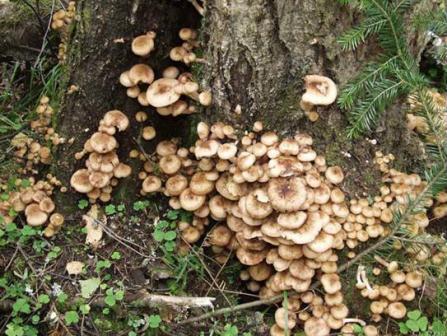
- False honey mushrooms are tasty in smell, have a mushroom aroma, while inedible mushrooms have an unpleasant and earthy aroma.
- In inedible mushrooms, the caps are the most brightly and loudly colored, in contrast to the opposite ones. Shades can be sulfur yellow or pale red, it all depends on the species. For non-false mushrooms, the usual light brownish color is characteristic.
- In edible honey agarics, the top has small scales, while in the opposite ones there is nothing on it, it is smooth to the touch. But this does not apply to the old false mushrooms, since they also have a smooth hat.
- If we compare the seamy part of mushroom caps, they also have differences in color. The plates of inedible mushrooms are yellow, while in the old ones it is green or olive-black. And in real mushrooms, they are creamy or yellowish-white.
- In terms of taste, false mushrooms have a bitter taste, but you should not try mushrooms, all of the above signs are quite enough to determine the edibility of the mushroom.
How and where to pick mushrooms, milk mushrooms, boletus, honey agarics
For an experienced mushroom picker, the listed qualities will immediately be remembered, and in the future they will help to distinguish, but for a beginner it is better to apply knowledge carefully and carefully. Since they are theoretical, and each person considers color and smell in their own way. Only experience will help to choose the right mushroom. And for the first hikes, one should start from the indicative moment in appearance - this is the presence of a skirt on the legs of honey agarics. Now it becomes clear when to collect hemp mushrooms and how to distinguish mushrooms by sight. demand to themselves special attention... Read our website site and you won't have any problems with them.
Honey mushrooms grow throughout Russia, where there are forest zones. The most common places to look for honey mushrooms are broad-leaved forests, with a predominance of birch, aspen, oak, alder. Sometimes they grow on the trunks and stumps of pine trees. Collection season for different types honey agarics vary. Spring mushrooms appear in May and continue to grow until the end of June. Then the season for collecting summer mushrooms begins - from July to the end of August. Autumn mushrooms, which are the most popular among fans of "quiet hunting", begin to bear fruit from the end of August and continue until the end of October, and in some regions of Russia, where the climate is mild and warm, until mid-November.
For novice mushroom pickers, advice is given on where to look for mushrooms in the forest. So, the areas where these mushrooms grow should be with high humidity. Honey mushrooms begin to grow especially well after autumn fogs. If you have collected these fruiting bodies on one stump or tree, then literally in 2-4 days you can return here for a new harvest.
Honey mushrooms are well transported, therefore, unlike other mushrooms, they can even be collected in packages or bags. These fruiting bodies are almost never wormy. Due to their versatility, honey mushrooms are used in all culinary processes. They are fried, boiled, stewed, pickled, fermented, dried, frozen. Sauces are prepared from them, and. Even after heat treatment, these mushrooms do not lose their nutritional properties.
A distinctive feature of autumn mushrooms is their glow in dark time days. So, at night you can immediately see in the forest where to look for mushrooms. In addition to the caps of these fruit bodies, the threads of the mycelium also glow, which penetrate the wood and it seems that the whole tree is illuminated.
Where to look for meadow, autumn and winter mushrooms?
It is very important to remember that in those places where you will be looking for autumn mushrooms, you need to carefully monitor so that they do not end up in the basket. false mushrooms... False honey mushrooms are poisonous, so it is necessary to be able to distinguish real honey mushrooms from inedible ones. Note that autumn mushrooms grow only on a tree or stump. Sometimes it can be found on the ground, but with one condition: rotting tree roots pass under the surface. False mushrooms grow only on the ground, so don't be lazy, dig the ground and make sure what mushrooms you find. In addition to these signs, false mushrooms have green or green-gray plates under the cap. The false honey agaric has no scales on the cap, and there is no film “skirt” on the leg. When you find a tree or stump with honey agarics in the forest, make sure that they are suitable for all signs of edible mushrooms. You can even lick the hat: if it is bitter, these are false mushrooms, and they have an unpleasant smell.
As noted, honey agaric mushrooms are divided into several types, and the time of their collection is also different. For example, where to look for meadow mushrooms that grow from May to June, and the second wave starts from August to the end of September? Usually, meadow mushrooms are found in damp ravines, in fields, along roadsides and even in gardens. Many people confuse this species with toadstools, and therefore do not collect it. But note that these fruiting bodies are very tasty and nutritious, although they do not grow as densely as autumn or winter mushrooms.
As the name suggests, each mushroom picker will be able to tell where to look for mushrooms. In any deciduous or pine forest, felling is carried out. It is these places that are considered the best for growing honey agaric. Often in the forest you can find a fallen tree, or rotten stumps, strewn with these small fruiting bodies. If you have found such a "fruitful" place for mushrooms, do not rush to leave. Look around carefully and you may be able to see another stump with honey agarics. If you have friends who have experience in picking mushrooms, then ask them where it is better to look for mushrooms, in what places.
Autumn mushrooms bear fruit in only 2-3 weeks, dividing into 2 waves. But in some regions of Russia, there are 3 waves of fruiting of these mushrooms. Everything here will depend on the climate of a particular area, as well as on weather conditions. It should be noted that honey mushrooms do not grow only in permafrost and tropics. This type of mushroom is considered the most popular because it can be harvested all year round: in spring, summer, autumn and even winter.
Many are perplexed by the question: where to look for winter mushrooms and is it possible? Winter mushrooms are the only type of mushrooms that have no false and poisonous counterparts. You can freely go to the forest even in winter period and look for these beautiful, vibrant mushrooms.
Throughout the winter, these fruiting bodies do not deteriorate, and as soon as the thaw begins, they begin to grow again. These mushrooms also grow on trees, but at a higher height than autumn ones. Therefore, in search of winter mushrooms with you, you should take a stick with a hook to shoot them. In addition, you need to remember the places where honey mushrooms were found. V next year feel free to return to this place and gather a new crop.








